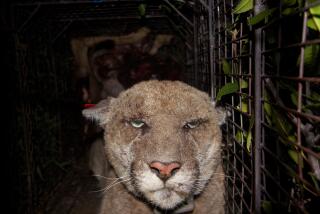Death Rides the Range
- Share via
The unhappy legacy of Anne Gorsuch Burford lives on at the Environmental Protection Agency. As a result, somewhere around the middle of June the EPA is expected to approve the use of the poison sodium fluoroacetate for the killing of wild animals--most notably the coyote.
Sodium fluoroacetate, commonly known as Compound 1080, is highly toxic to all species of animals and birds, and there is no effective antidote. Compound 1080 was, however, very popular with sheep ranchers who typically would lace the carcass of a sheep or horse with the pesticide and leave it on the range for the coyotes to eat.
The problem was that other birds and animals ate the poisoned meat, too. The unintended victims included a number of golden eagles and, reportedly, one or more grizzly bears. Reacting to the subsequent outrage in 1972, the Nixon Administration banned all uses of Compound 1080 along with sodium cyanide, strychnine and thallium. The 1080 ban, which included a prohibition of interstate shipment of the poison, was continued by the Ford Administration and the Carter Administration in spite of intense pressure from the livestock industry to permit its use.
Early in the new Reagan Administration, however, the ban on interstate shipment of 1080 was removed, thus facilitating its use on private rangelands. Then Burford, EPA administrator at the time, announced that new evidence had come to light that could justify the use of 1080 once again on a widespread basis, including its use on federal rangeland leased to ranchers. Burford set in motion a series of hearings that led to conditionalapproval by current Administrator Lee M. Thomas for the use of 1080 in toxic collars attached to the necks of sheep and in selectively placed bait that would contain only enough poison, presumably, to kill one coyote at a time.
The next and final step is for the EPA to issue specific regulations under which 1080 could be used.
It is unclear just what the new evidence is that would justify the use of 1080. In his earlier order, Thomas acknowledged EPA findings that overall predation by coyotes has not increased appreciably since 1972, when 1080 was banned, and that only a minority of sheep ranchers are affected. In the very next paragraph Thomas said, “The record is replete with references to devastating losses suffered by many individual ranchers as a result of coyote predation.”
Even ranchers will acknowledge that the toxic collar is, at best, a limited solution. The idea is that when the coyote goes for the throat of the sheep, it punctures the collar and gets a dose of poison. But the collars are expensive, and are not likely to be used extensively in large herds in open range. The sheep dies anyway, and in some tests the coyote went for the hindquarters rather than the throat. Other means, including the use of guard dogs, are likely to be more effective.
There already is evidence of increasing illegal use of 1080 and other banned poisons, and of new eagle kills. Once 1080 is back on the market, it is only a matter of time before indiscriminate death rides the range once again. There is one simple way to prevent that: for EPA to acknowledge its mistake and say no.
More to Read
Sign up for Essential California
The most important California stories and recommendations in your inbox every morning.
You may occasionally receive promotional content from the Los Angeles Times.










